What will you see during the tour?
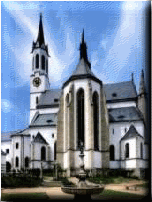 The town and the monastery Vyšší Brod are both situated on the upper right bank of the Vltava river in the foothills of the Bohemian Forest, in a romantic landscape amidst thick forests.
The town and the monastery Vyšší Brod are both situated on the upper right bank of the Vltava river in the foothills of the Bohemian Forest, in a romantic landscape amidst thick forests.
Cistercian Abbey in Vyšší Brod (Latin: „Altovadum“, German: „Hohenfurth“) was founded on June 1st,1259 by the nobleman Vok of Rosenberg. The legend holds that the nobleman founded the monastery out of gratitude for his miraculous rescue out of the stormy Vltava river as he had turned to the Blessed Virgin Mary for help while drowning. The Rosenberg dynasty died out in 1611 but Cistercians have been praying for the repose of their souls until the present time.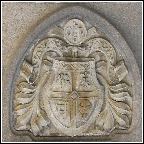 The monastery was returned to the Order after 40 years of communist rule and the monks currently strive to restore it to become once again the region’s spiritual and cultural center. After the Rosenbergs, the aegis over the monastery passed on to the Eggenbergs, and in 1719 to the Schwarzenbergs. From 1941-45, the monastery was confiscated on behalf of the Nazi „SS“ needs, and between 1950 and 1990, it was run by the Czechoslovak communist government merely as a museum. The core of the monastery was returned to the Cistercians in 1991.
The monastery was returned to the Order after 40 years of communist rule and the monks currently strive to restore it to become once again the region’s spiritual and cultural center. After the Rosenbergs, the aegis over the monastery passed on to the Eggenbergs, and in 1719 to the Schwarzenbergs. From 1941-45, the monastery was confiscated on behalf of the Nazi „SS“ needs, and between 1950 and 1990, it was run by the Czechoslovak communist government merely as a museum. The core of the monastery was returned to the Cistercians in 1991. 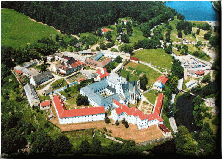 Visiting a Cistercian monastery only makes sense if combined with understanding the monastery’s spiritual basis. The architecture and art can be understood if the visitor is acquainted with the spirituality expressed in them. It was just this climate that gave birth not only to this and other monasteries, but to all of European culture.
Visiting a Cistercian monastery only makes sense if combined with understanding the monastery’s spiritual basis. The architecture and art can be understood if the visitor is acquainted with the spirituality expressed in them. It was just this climate that gave birth not only to this and other monasteries, but to all of European culture.
The Cistercians are reformed Benedictine monks: they strive to live the Christian way of life within the Catholic Church according to the Rule of St. Benedict, written for monks in the 6th Century. The Rule is a collection of wisdom and instructions, and is an extension of the ideas in the Gospel. The Cistercians live this Rule in a deeper way, striving toward solitude, silence, personal labor, and simplicity. They live their whole life in one location within a community under the guidance of a communally elected abbot.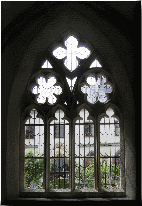 The Cistercians emerged in the eve of the 11th Cent. as Europe’s first religious order. They spread vigorously thanks to the most influential personality of the 12th Century – the fascinating St. Bernard of Clairvaux. Their reform of the commonly employed Rule has proved the most successful. That’s why the Order has endured, though with numerous adaptations, until today, and continues to be forward for the Church. It is possible to describe briefly the sense of the monastic life thus: the monastery is “a school for the Lord’s service” or “a school of a progress in love”, or, to use a biblical parallel, it is “a prefiguration of the heavenly Jerusalem” (Revel. X:X).
The Cistercians emerged in the eve of the 11th Cent. as Europe’s first religious order. They spread vigorously thanks to the most influential personality of the 12th Century – the fascinating St. Bernard of Clairvaux. Their reform of the commonly employed Rule has proved the most successful. That’s why the Order has endured, though with numerous adaptations, until today, and continues to be forward for the Church. It is possible to describe briefly the sense of the monastic life thus: the monastery is “a school for the Lord’s service” or “a school of a progress in love”, or, to use a biblical parallel, it is “a prefiguration of the heavenly Jerusalem” (Revel. X:X).
ABBEY CHURCH has always been the undetachable part of the monastery. Its foundations followed closely the monastery’s foundation in the 13th Century, yet the construction was not finished until after approx. a hundred years, in the 1350s. The church’s groundplan shaping a cross is directed to the east. The two side naves are as high as the central one. In the transept, that is characteristically Cistercian, there are four inset chapels. Concerning the church’s dimensions, the height is 17.5 mts incl. vault, 52 mts long, and the transept is 29 mts wide.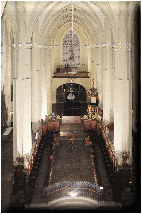 MONASTIC CHOIR STALLS are located in the middle of the nave’s center. It was commissioned by Abbot Candidus Heindrich about 1725 and created by the monastery’s lay-brother Josef Raffer who also designed the confessionals in the church and the bookcases in the library. The choir is crafted of extensively inlaid and gilt wood while the sculptures of the famous Church personalities adorn its upper edge. The choir is indispensable for the monastic life and is used, besides meditation, for the full cycle of communal prayer: i.e. the singing and/or recitation of the canonical hours (i.e. at specific times of the day). Two oldest altars of all the eight ones in the church are noteworthy: the late gothic altars of St. Barbara (1525, left) and of St. Rochus (1524, right). The church is equipped with two organs. The larger is to be found above the entrance on the baroque gallery, while the small one is built into the choir’s left side.
MONASTIC CHOIR STALLS are located in the middle of the nave’s center. It was commissioned by Abbot Candidus Heindrich about 1725 and created by the monastery’s lay-brother Josef Raffer who also designed the confessionals in the church and the bookcases in the library. The choir is crafted of extensively inlaid and gilt wood while the sculptures of the famous Church personalities adorn its upper edge. The choir is indispensable for the monastic life and is used, besides meditation, for the full cycle of communal prayer: i.e. the singing and/or recitation of the canonical hours (i.e. at specific times of the day). Two oldest altars of all the eight ones in the church are noteworthy: the late gothic altars of St. Barbara (1525, left) and of St. Rochus (1524, right). The church is equipped with two organs. The larger is to be found above the entrance on the baroque gallery, while the small one is built into the choir’s left side.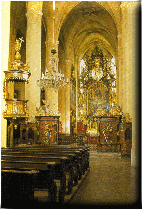 HIGH ALTAR in the early baroque style fills the whole frontal area of the presbytary. It was created by two Cistercian lay-brothers: Linhart Wulliman, the woodcarver, and Georgius, the painter. The altar is made of extensively gilted wood, and its central picture changes four times a year according to the liturgy periods . The painting of the Assumption of the Virgin Mary, who is the patron-saint of both the monastery and the Cistercians, was been painted by Josef Houska (1654) according to the model by Josef Heinz. The Feast of the Assumption is celebrated on August 15th. On the altar sides, two larger-than-life statues are to be noted: Pope Eugen III, the first pope of Cistercian origin, and St. Bernard of Clairvaux, one of the primary Cistercian patron-saints. The side walls of the presbytery were originally decorated with gothic frescos that were largely destroyed in the 19th Century. Today, their fragments are covered by two canvas paintings from the 19th Century. The one on the right by Josef V. Hellich illustrates the miraculous rescue of Vok of Rosenberg, the founder of the monastery, out of the swollen Vltava River, while the painting on the left by Bart. Čurna depicts the arrival of the first monks in the monastery, and the dedication of the church to the Blessed Virgin Mary by Vok of Rosenberg and his wife Hedwig of Schaumburg.
HIGH ALTAR in the early baroque style fills the whole frontal area of the presbytary. It was created by two Cistercian lay-brothers: Linhart Wulliman, the woodcarver, and Georgius, the painter. The altar is made of extensively gilted wood, and its central picture changes four times a year according to the liturgy periods . The painting of the Assumption of the Virgin Mary, who is the patron-saint of both the monastery and the Cistercians, was been painted by Josef Houska (1654) according to the model by Josef Heinz. The Feast of the Assumption is celebrated on August 15th. On the altar sides, two larger-than-life statues are to be noted: Pope Eugen III, the first pope of Cistercian origin, and St. Bernard of Clairvaux, one of the primary Cistercian patron-saints. The side walls of the presbytery were originally decorated with gothic frescos that were largely destroyed in the 19th Century. Today, their fragments are covered by two canvas paintings from the 19th Century. The one on the right by Josef V. Hellich illustrates the miraculous rescue of Vok of Rosenberg, the founder of the monastery, out of the swollen Vltava River, while the painting on the left by Bart. Čurna depicts the arrival of the first monks in the monastery, and the dedication of the church to the Blessed Virgin Mary by Vok of Rosenberg and his wife Hedwig of Schaumburg.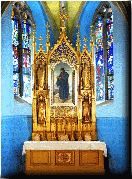 ST. BENEDICT CHAPEL – There is in the floor set the tombstone of Count Jan Zrinský, who, as the heir of the Rosenberg domain after 1597, died without an heir. His mother was the last Rosenberg, Lady Eva of Rosenberg, and his father Nicolaus Zrinský, a famous warrior against Turks.
ST. BENEDICT CHAPEL – There is in the floor set the tombstone of Count Jan Zrinský, who, as the heir of the Rosenberg domain after 1597, died without an heir. His mother was the last Rosenberg, Lady Eva of Rosenberg, and his father Nicolaus Zrinský, a famous warrior against Turks.
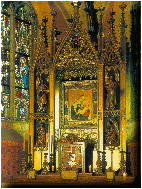 ST. BERNARD CHAPEL contains the figural tombstones of the 17th century abbots.
ST. BERNARD CHAPEL contains the figural tombstones of the 17th century abbots.
VIRGIN MARY CHAPEL presents on a neogothic altar the painting-on-wood of the graceful Virgin Mary, famous as the „Madonna of Vyšší Brod“. This panel painting is of immense artistic value, and was created soon after 1400. Concerning its style and the Bohemia’s patron-saints in the lower part of the frame, the painting is to be attributed to the Bohemian School. As usual in the Middle Ages, the painter remains unknown. The exposed painting is a copy from 1939 by Prof. Bohuslav Slánský. The monastery’s oldest part – currently the sacristy – lies next to the transept’s south side. Above the doorway to the sacristy, there is a beautifully sculpted portal (tympanum) showing the Foxes in the Wineyard, a motif from the Old Testament.
Above the doorway to the sacristy, there is a beautifully sculpted portal (tympanum) showing the Foxes in the Wineyard, a motif from the Old Testament.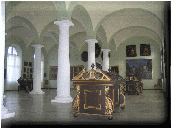 THE PAINTINGS´ GALLERY is situated in the 1st floor above the cloister’s western wing. The previous monastic cells were made into a neoclassical gallery bet. 1835-38 according to a design by K. Jambora from Český Krumlov. This three-naved hall implements the Bohemian vaults with the Tuscan pilling. Its highlights are the collections of baroque Bohemian paintings, particularly the works by Peter Brandl, Jan Kašpar Hirschelly, and Norbert Grund. The art collections, returned by the state, also include liturgical articles from 17th and 18th Centuries.
THE PAINTINGS´ GALLERY is situated in the 1st floor above the cloister’s western wing. The previous monastic cells were made into a neoclassical gallery bet. 1835-38 according to a design by K. Jambora from Český Krumlov. This three-naved hall implements the Bohemian vaults with the Tuscan pilling. Its highlights are the collections of baroque Bohemian paintings, particularly the works by Peter Brandl, Jan Kašpar Hirschelly, and Norbert Grund. The art collections, returned by the state, also include liturgical articles from 17th and 18th Centuries.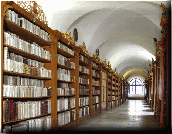 THE LIBRARY PASSAGE originated in the same time as the gallery and contains predominantly later, specialized books. The medallion pictures of the abbots from the 16th to the 19th Centuries that are exposed above the book-cases are particularly noteworthy.
THE LIBRARY PASSAGE originated in the same time as the gallery and contains predominantly later, specialized books. The medallion pictures of the abbots from the 16th to the 19th Centuries that are exposed above the book-cases are particularly noteworthy.
THE PHILOSOPHICAL HALL is the smaller one of both the library’s halls, 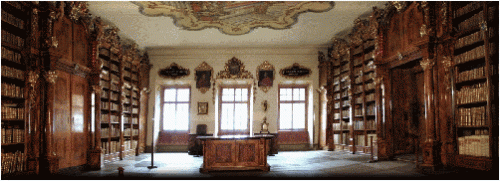 and contains literature from various fields of study, but mostly Philosophy. On the ceiling there is a fresco by the monastery’s lay-brother Lukáš Vávra (late 18th Century). It depicts a motif from the Old Testament: Salomon sits in judgement. The very detailed map of Bohemia by Müller (1720) is presented on the desk, covered with glass. The quotations by St. Bernard above the windows praise scholarship resulting in a service to others. Currently, the library contains slightly more than 70,000 volumes, 200 parchment and 1000 paper manuscripts, and 400 incunabula, i.e. books printed before the year 1500.
and contains literature from various fields of study, but mostly Philosophy. On the ceiling there is a fresco by the monastery’s lay-brother Lukáš Vávra (late 18th Century). It depicts a motif from the Old Testament: Salomon sits in judgement. The very detailed map of Bohemia by Müller (1720) is presented on the desk, covered with glass. The quotations by St. Bernard above the windows praise scholarship resulting in a service to others. Currently, the library contains slightly more than 70,000 volumes, 200 parchment and 1000 paper manuscripts, and 400 incunabula, i.e. books printed before the year 1500.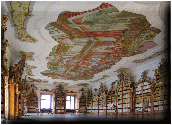 THE THEOLOGICAL HALL is the largest room in the monastery’s library. It encompasses theological literature, from which the collection of Bibles in more than 40 languages is notable. The white hogskin bindings were manufactured in the mid-18th Century thanks to Quirinus Mickl, a highly educated abbot of that time.
THE THEOLOGICAL HALL is the largest room in the monastery’s library. It encompasses theological literature, from which the collection of Bibles in more than 40 languages is notable. The white hogskin bindings were manufactured in the mid-18th Century thanks to Quirinus Mickl, a highly educated abbot of that time. 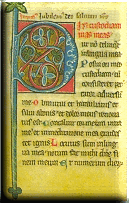 The portrait hanging above the entrance depicts him at his peak, at the age of 45 in 1756. The ceiling fresco is by L. Vávra (18th Century). It expresses again a biblical motif, this time, however, from the New Testament: the 12-year-old Jesus is shown teaching in the Jerusalem Temple.
The portrait hanging above the entrance depicts him at his peak, at the age of 45 in 1756. The ceiling fresco is by L. Vávra (18th Century). It expresses again a biblical motif, this time, however, from the New Testament: the 12-year-old Jesus is shown teaching in the Jerusalem Temple.
